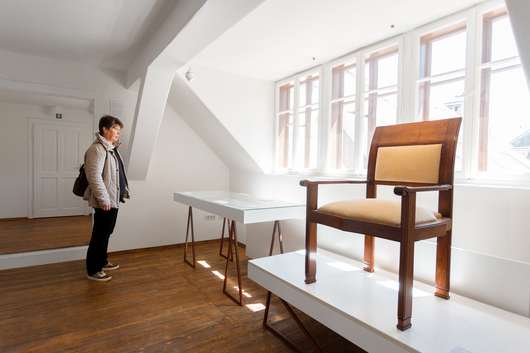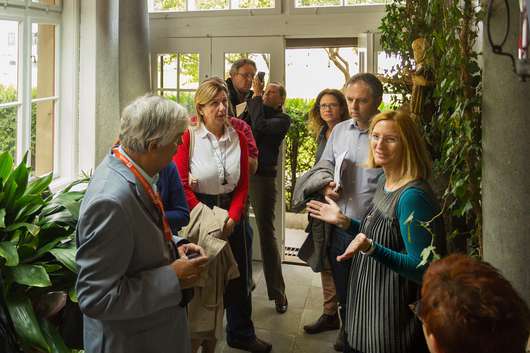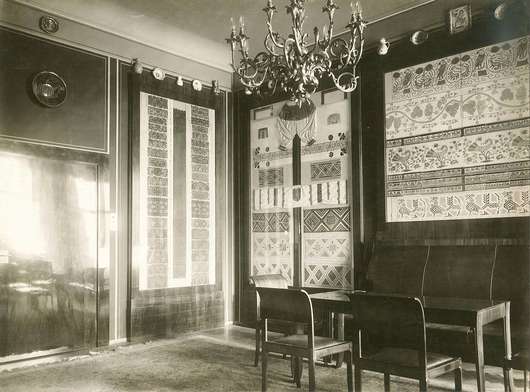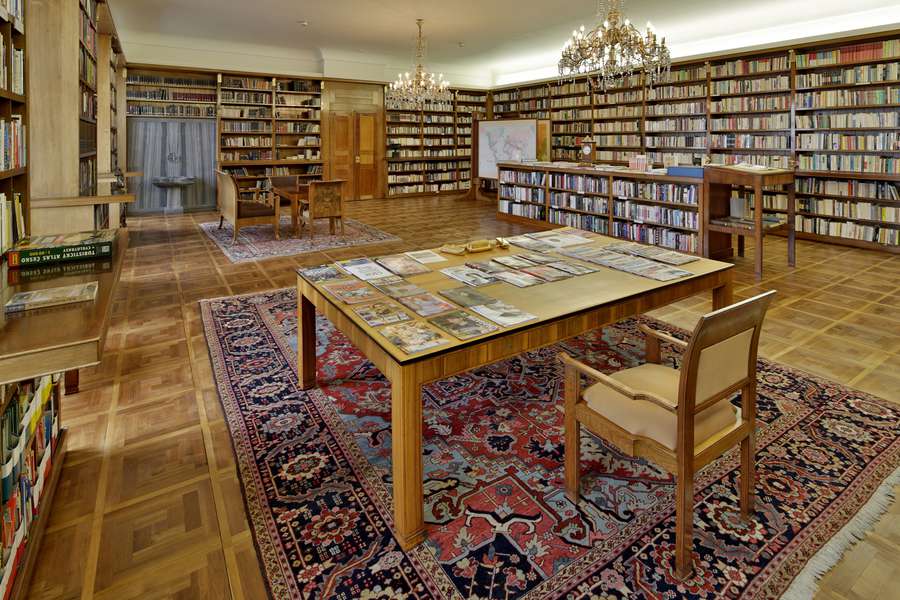Plečnik and Prague Castle: Apartment for the First President of Czechoslovakia
Spring in the Plečnik House is in the sign of our collaboration with the Archives of Prague Castle. The final product of this collaboration, the exhibition Plečnik and Prague Castle, focuses on Plečnik’s designs for the rearrangement and equipment of the private presidential areas in the Prague Castle, and on important personal connections Plečnik had with Masaryk and his daughter Alice.
Plečnik was entrusted with the renovation of Prague Castle by Tomaš Garrigue Masaryk (1950−1937), the first democratically elected president of Czechoslovakia. A change in the character of the Castle intended to make it into the seat of a democratic president was, for Masaryk, a matter of educating the nation As for Plečnik, it only strengthened his conviction about the significance of national culture. The architect was very sympathetic to Masaryk’s views on philosophy and social issues, his humanism and ethical attitude. The artist and the President established a relationship of mutual respect and understanding.
In a letter, written by Masaryk to Plečnik on 29 March 1923, we can read, "Something remarkable could be made of the castle and its surrounding and I can see nobody else but You capable of carrying out this historic task."
The exhibition Plečnik and Prague Castle: Apartment for the first president of Czechoslovakia will present plans and photographs of the originally designed areas in the 1930s, as well as authentic Plečnik chairs. This is an important theme in Plečnik’s oeuvre, which to this day connects Prague and Ljubljana.
Authors of the exhibition: Martin Halata, MA, and architect Michal Šula
About the exhibition
The ethos of the first Czechoslovak Republic, whose 100th anniversary will be celebrated in 2018, still draws a great deal of attention from both professionals and the lay public. An important role in the history of the first independent state of people from Bohemia, Moravia, Slovakia and Ruthenia was played by Prague Castle.
In October 1918, the monarchical headquarters became the apartment and office of the first Czechoslovak president, Tomáš G. Masaryk, and his extended family. To transform the seat of the monarchy, Prague Castle, into a new symbol of democracy was not easy. The commission for the design of the apartment for the president’s family was at first given to the Dome architect, Kamil Hilbert. He designed a provisional apartment on the first floor (piano nobile) of the New Palace at the so-called City Wing, visible on the Hradčany horizon from the south when viewed from the waterfront. Hilbert is also the author of the idea to build the presidential apartment rather on the second floor than on the Habsburg' first floor. As an architect, he was aware of the obvious advantages of this transformation: unlike the first floor, the second one was equipped with modern conveniences, it used to be inhabited by members of the Habsburg dynasty, but it had been half-empty since 1890.
The commission for the project for the final apartment and office of President T.G. Masaryk on the second floor was awarded to Jan Kotěra, the architect who largely worked for bourgeois circles and whose work after 1918 featured elite-conceived decorative motifs. Kotěra worked on his design in the summer of 1921, when he drew up complete plans. The Masaryks rejected the design in September 1921, saying it re-coated the Habsburg layer with a bourgeois layer. Alice G. Masaryk told Plečnik of her concerns that Kotěra’s design might be popular for its stylishness and modernity (i.e. what lifestyle magazines today call trends). She wanted simplicity, conciseness, colour temperance, and silent recollection – all very different from Kotěra’s designs!
Kotěra was so generous he introduced Jože Plečnik to the Masaryks. The Slovenian architect and his sober and spiritual conception of architecture were much closer to T.G. Masaryk’s nature and his daughter Alice’s spirituality than the somewhat conventional architect.
Masaryk showed interest in the work of the Slovenian architect, and on 14th August 1921, he asked him to rebuild the presidential apartment. In Plečnik’s design, Masaryk’s apartment of January 1922 was a combination of a large private apartment, the presidential office and official premises. It occupied almost the entire second floor of the New Palace with the entrance to the third courtyard and a private entrance from the presidential alley – the so-called tunnel from the second courtyard where the presidential private elevator was installed.
The centre of the apartment was the impluvium (also known as the Indoor Garden), surrounded by the presidential apartment and offices in the south and two halls – the Harp Hall and the Heraldic Hall for the high inter-state protocol – in the north.
The presidential office and the secretary’s office were situated at the eastern end of the apartment; the other end of the apartment was to be crowned with the Ladies’ (Embroidery) Lounge, the Social (Green) Parlour, and the Music Parlour. Between the reception rooms and the presidential office in the east, private family rooms were situated: the bedroom and reading room, bathrooms, toilets, and changing rooms. Alice G. Masaryk was very interested in the project and continually cooperated with Plečnik. Together, they selected historic furniture, and they also shared their spiritual work. Plečnik and his collaborators designed new furniture, as well.
The apartment was completed in late 1929, and Plečnik left Prague the following year. Alice believed their great work on the presidential apartment, as well as the ideal transformation of Prague Castle and its surroundings would not end, and she hoped the Slovenian architect would come back. Plečnik did visit Prague several times, and his final stay in the city was in 1934. His sensitive and perhaps difficult relationship with Alice G. Masaryk is reflected in rare surviving letters.
After 1930, Alice asked the well-functioning civil administration of Prague Castle, namely Plečnik’s collaborator, the architect Otto Rothmayer, to adapt the private apartment for her family: the so-called Family Room with functional furniture was designed by Jan Valerián Vaněk. This move away from the close cooperation with Jože Plečnik seemed to foreshadow the following years: Masaryk’s protracted health crisis that began in 1934 continued, and on 14 December 1935, he eventually resigned from the office of the Czechoslovak president in his family circle. The same year, Jože Plečnik, living in Ljubljana, resigned from his role as Prague Castle architect.
—Martin Halata and Michal Šula
Colophon
PLEČNIK AND PRAGUE CASTLE: apartment for the first president of Czechoslovakia, temporary exhibition, 21. 4.–25. 6. 2017
Museum and Galleries of Ljubljana, Plečnik House, represented by: Blaž Peršin, Director
Authors of the exhibition: mag. Martin Halata, Michal Šula (Prague Castle Archives – The Office of the President of the Czech Republic)
Photographs by: Prague Castle Archives, Jan Gloc, dr. Damjan Prelovšek, Ondřej Přibyl
Expert consultant: Ana Porok (MGML)
Graphic and exhibition design: Bojan Lazarevič, Agora Proars
Language editing: Eliška Bernardova, dr. Tomo Jurca
English translation: Sylva Ficová, Matic Šavli
Slovene translation: Nives Vidrih, Jana Šnytová
Documentation: Ondřej Přibyl
Promotion: Maja Kovač, Ana Modic
Exhibition installation: OKvir, Technical services of MGML
Location
Karunova 4–6
1000 Ljubljana
T +386 1 280 16 04 (reception)
T +386 1 241 25 06
E plecnik@mgml.si
Opening hours
Tuesday–Sunday: 10:00–18:00
Monday: Closed
1 January, 1 November, 25 December: Closed
24 and 31 December: 10:00–14:00
Tickets
Visits of the original Plečnik’s home are only possible with a guided tour that begins every full hour.
RECOMMENDED: you can buy your tickets online and book your date here.
For more information, please contact plecnik@mgml.si or +386 1 280 16 04.
Visiting the Plečnik House (price includes permanent exhibition Plečnik and a guided tour of Plečnik's home)
Adults: 8 €
Students: 6 €
Children: 6 €
Adults over the age of 60: 6 €
Families: 18 €
Unemployed visitors: 6 €
Visitors with disabilities: 6 €
Free admission for carers
ICOM, PRESS, SMD: free admission
Guided tours for private groups of more than 7 visitors need to be booked at least 5 working days in advance.
Visiting the Plečnik House with a prior reservation
Groups of up to 4 persons: 38 €
Groups of over 4 persons: 9 €/person, reduced 7 €/person
Visiting the permanent exhibition Plečnik
Adults: 5 €
Students: 3 €
Children: 3 €
Adults over the age of 60: 3 €
Families: 12 €
Unemployed visitors: 3 €
Visitors with disabilities: 3 €
Free admission for carers
ICOM, PRESS, SMD: free admission
Press kit
Events




